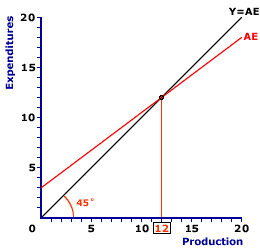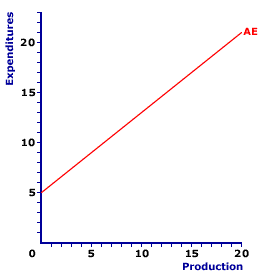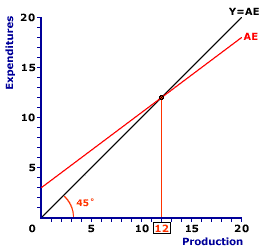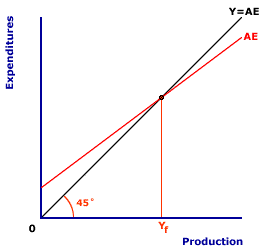
|
|
AGGREGATE: A common modifier for an assortment of economic terms used in the study of macroeconomics that signifies a comprehensive, often national, total value. This modifier most often surfaces in the study of the AS-AD, or "aggregate market", model of the economy with such terms as aggregate demand and aggregate supply. For example, aggregate demand indicates the total demand for production in the macroeconomy and aggregate supply indicates the total amount of that output produced. Two other noted "aggregate" terms are aggregate expenditures and aggregate production function.
Visit the GLOSS*arama
|
|


|

|
                           KEYNESIAN ECONOMICS: A theory of macroeconomics developed by John Maynard Keynes based on the proposition that aggregate demand is the primary source of business-cycle instability and the most important cause of recessions. Keynesian economics points to discretionary government policies, especially fiscal policy, as the primary means of stabilizing business cycles and tends to be favored by those on the liberal end of the political spectrum. The basic principles of Keynesian economics were developed by Keynes in his book, The General Theory of Employment, Interest and Money, published in 1936. This work launched the modern study of macroeconomics and served as a guide for both macroeconomic theory and macroeconomic policies for four decades. Although it fell out of favor in the 1980s, Keynesian principles remain important to modern macroeconomic theories, especially aggregate market (AS-AD) analysis. Keynesian economics can be traced to the pioneering work of John Maynard Keynes (often referred to as the father of macroeconomics). The specific event launching the modern study of macroeconomics and Keynesian economics was the publication by John Maynard Keynes of The General Theory of Employment, Interest and Money in 1936.Keynesian economics dominated the study of economics for 40 years after it was introduced. It fell out of favor in the 1980s largely because it did not adequately explain the simultaneous occurrence of high rates of unemployment and inflation that came to be known as stagflation. Highlight of Keynesian economics include: - One, Keynesian economics offers a theoretical explanation of, and a remedy for, persistent unemployment problems, especially those occurring during the Great Depression.
- Two, the theoretical structure of Keynesian economics is based on a view that the macroeconomy is a distinct entity operating accord a set of principles distinct from those governing microeconomic phenomena. The macroeconomy economy is more than just a collection of markets.
- Three, these macroeconomic principles of Keynesian economics indicate that aggregated markets, especially resource markets, do not automatically achieve equilibrium, meaning full employment',500,400)">full employment is not guaranteed.
- Four, Keynesian economics indicates that the recommended way to achieve full employment is through government intervention, especially fiscal policy.
A Little HistoryKeynesian economics was developed by John Maynard Keynes in response to the Great Depression of the 1930s. During this decade-long period of economic stagnation and financial turmoil, the unemployment rate in the United States hit a peak of almost 25 percent. During the period from 1931 to 1940, the U.S. unemployment rate NEVER fell below 14 percent. Unemployment was high and persistent, and contrary to the existing macroeconomic theory--classical economics.Classical economics, as it has come to be known, was effectively launched with the publication of An Inquiry into the Nature and Causes of the Wealth of Nations by Adam Smith in 1776. This work was the first to provide a consolidated theory and analysis of economics and is credited with launching the modern study of economics. Most important for Keynesian economics, it created the foundation for the classical analysis of macroeconomics. Classical economics rests on three key assumptions: - Flexible Prices: The first is that prices are flexible and thus markets are able to quickly and efficiently achieve equilibrium. The attainment of equilibrium eliminates shortages and surpluses, which when applied to resource markets, means that full employment is maintained and unemployment is not a problem.
- Say's Law: The second assumption is that the aggregate production of good and services generates enough income to exactly purchase all output. Captured by the phrase "supply creates its own demand," Say's law indicates that business-cycle instability caused by an mismatch between aggregate demand and aggregate supply is a rare and temporary occurrence.
- Saving-Investment Equality: The last assumption ensures that Say's law holds because any decrease in consumption demand for output due to saving is replaced by an equal amount of investment demand. The saving-investment equality is assured by applying the notion of flexible prices to interest rates in the financial markets.
Classical economics dominated the study of economics for 150 years and continues as the foundation of modern microeconomics. In fact, there was no distinction between macroeconomics and microeconomics during this period. The theory of markets, prices, and equilibrium was applied to all economic phenomena, with little regard for the modern division between microeconomics and macroeconomics.Over this 150-year period, classical economics was improved, refined, and enhanced. Some economists directed attention to microeconomic topics, others to macroeconomic topics. On the macroeconomic front, classical economics indicated that full employment was the natural state of the economy and could be and would be maintained without government intervention. This theory not only dominated the study of economics, it was the philosophical guide to government policies in the early 1900s, which undoubtedly played a role in the length and severity of the Great Depression. More to the point, the onset of the Great Depression and the resulting problems that persisted throughout the decade refuted the basic full employment implications of classical economics and paved the way for the emergence of Keynesian economics. Ironically, after four decades of dominance, flaws in Keynesian economics were revealed by another macroeconomic phenomenon, stagflation. During the 1970s, supply-side shocks to the economy, especially caused by higher oil prices, caused economic instability with the simultaneous occurrence of both higher unemployment rates and higher inflation rates. This contradicted the basic implications of Keynesian economics and led to the formation of modern aggregate market analysis (or AS-AD analysis) as a synthesis and advancement of both classical economics and Keynesian economics. Keynesian CritiqueKeynesian economics not only put forth a new theory of macroeconomics, it also suggested where classical economics went wrong, why it was unable to explain the length and severity of the Great Depression. A discussion of each of the three assumptions of classical economics provides a bit of insight.- Flexible Prices: First up is the proposition that wages and prices are inflexible, rather than flexible as assumed in classical economics. Prices might be inflexible, especially in the downward direct, because sellers are reluctant to accept lower prices. Inflexible, or rigid, prices thus prevent markets from eliminating shortages and surpluses. In particular, rigid wages allow a surplus of labor (that is, unemployment) to persist.
- Say's Law: The question also arises whether supply does in fact create demand, as assumed by Say's law. While, in principle, revenue generated by production ultimately ends up as household income, this does not happen instantaneously. In the meantime, households can only spend the income that they actually have. If they have less income, then they spend less, less is sold, less is produced, and less revenue is generated.
- Saving-Investment Equality: Another possible problem is the assumed equality between saving and investment. The lack of flexible prices might also prevent equilibrium in financial markets. Moreover, the attainment of equilibrium might actually require negative interest rates. In particular, a disequilibrium in which saving exceeds investment means aggregate demand falls short of aggregate production and is just the sort of thing that would create a sustained depression.
Combining these three critiques indicates why high unemployment rates persisted during the Great Depression. Aggregate demand fell short of production, probably due to a lack of investment expenditures. Resource owners had less income and thus reduced their expenditures. Unemployment increased and the surplus of resources persisted because resource prices did not decline to restore balance.Keynesian AssumptionsTo replace the questionable assumptions of classical economics, Keynesian economics provides three comparable assumptions:- Rigid Prices: Contrary to the notion of flexible prices, Keynesian economics presumes that prices are inflexible or rigid, especially in the downward direction. Keynesian economics suggests that inflexible prices result from seller preferences (sellers prefer higher prices to lower prices and are reluctant to accept lower prices), long-term contracts (firms often have long-term contracts stipulating the prices paid for resources), employer preferences (employers often find it easier to lay off a few workers, when they reduce production cost, than to reduce the wages of every worker), and menu costs (firms are reluctant to change prices due to the cost of implementing the change, such as printing new price lists).
- Effective Demand: Contrary to Say's law, Keynesian economics is based on the notion of effective demand. Effective demand is the principle that consumption expenditures are based on the disposable income actually available to the household sector rather than income that would be available at full employment. This effective demand proposition is embodied in a key Keynesian principle, termed the consumption function, which is the relation between household consumption expenditures and household income. The consumption function indicates that people use only a fraction of any extra income for consumption.
- Saving and Investment Determinants: The primary reason for questioning the saving-investment equality presumed in classical economics rests with the determinants of saving and investment. Classical economics relies on the notion that saving and investment are both primarily dependent on the interest rate. A higher interest rate increases saving and decreases investment. A lower interest rate works in the opposite way. Keynesian economics, however, suggests that other factors have greater influence on saving and investment. In particular, household saving is based on household income and the desire to accumulate income for future spending. Business investment is based on the expected profitability of the goods produced with the capital.
The Basic Keynesian Model| Keynesian Cross |  |
The exhibit to the right is a graphical representation of the basic Keynesian model, commonly termed the Keynesian cross. The "cross" term refers to the intersection between two lines, the red AE line and the black Y=AE line.Before a closer look at each line, consider the construct of the exhibit. The vertical axis measures expenditures, specifically aggregate expenditures. The horizontal axis measures production, specifically aggregate production or gross domestic product. This exhibit indicates activity in the macroeconomic product markets, or the aggregate product market. Now consider the two lines. - Y=AE: The black Y=AE line, also termed the 45-degree line, indicates all points in the exhibit in which aggregate expenditures is equal to aggregate production, that is, the demand for gross domestic product is equal to the supply of gross domestic product. It is termed a 45-degree line, because it exactly bisects the 90-degree angle of the two axes and thus the angle formed with either axis is exactly 45 degrees. This further means that the slope of the 45-degree line is not only positive, but equal to 1. If the economy is operating on this 45-degree line, then the aggregate product market is in equilibrium.
- AE: The red AE line, or the aggregate expenditures line, indicates the relation between aggregate expenditures and aggregate production. The aggregate expenditures are the combined expenditures by the four macroeconomic sectors--consumption expenditures by the household sector, investment expenditures by the business sector, government purchases by the government sector, and net exports by the foreign sector. The slope of the AE line is also positive, but less than one. This slope captures the fundamental Keynesian concept of effective demand.
The intersection of the 45-degree line and AE line, which is $12 trillion in this exhibit, is equilibrium. At $12 trillion the aggregate expenditures on production is equal to aggregate production. All four sectors are able to purchase all of the output they want and all output produced is purchased by one of the four sectors. There is neither a surplus nor a shortage of aggregate production.If the economy is not producing the $12 trillion equilibrium level of aggregate production, then it automatically moves to that level. The key to this movement is business inventories (officially termed private inventories). - If, for example, aggregate production is something line $18 trillion, then aggregate expenditures fall short of aggregate production (indicated by the AE line being below the 45-degree line). In this case, all output produced is not sold, business inventories increase, and the business sector is motivated to reduce production, which moves the economy toward the $12 trillion equilibrium.
- Alternatively, if aggregate production is in the range of $6 trillion, then aggregate expenditures exceed of aggregate production (indicated by the AE line being above the 45-degree line). In this case, the four sectors cannot purchase more output that generated by current production, which they do from accumulated inventories, meaning business inventories decrease and the business sector is motivated to increase production, which also moves the economy toward the $12 trillion equilibrium.
As such, the Keynesian model, like most economic models, has a stable equilibrium. If equilibrium does not exist, the economy moves toward equilibrium. And once there, it remains.What About Full Employment?| Full Employment | 
|
A fundamental proposition of Keynesian economics is that the economy does not necessarily achieve full employment. This is indicated in the Keynesian cross model by one simple observation. Although equilibrium is achieved a $12 trillion, there is no indication how this level of aggregate production relates to full employment. The full employment of resources MIGHT generate $12 trillion of output. Then again, it MIGHT NOT. If $12 trillion is NOT full employment, two alternatives are possible. - Less Than Full Employment: If $12 trillion is less than the amount of aggregate production generated by full employment, then the result is a recessionary gap. A click of the [Less Than] button in the exhibit illustrate how this would look. In this case, the full employment level of aggregate production is $15 trillion. Because production fall short of full-employment production, the result is higher rates of unemployment. A recessionary gap is what plagued the U.S. economy throughout the Great Depression and they tend emerge in the modern economy to a lesser degree every 3 to 5 years.
- Greater Than Full Employment: If $12 trillion is greater than the amount of aggregate production generated by full employment, then the result is an inflationary gap. A click of the [Greater Than] button in the exhibit illustrate alternative looks. In this case, the full employment level of aggregate production is $9 trillion. Because production exceeds of full-employment production, the result is higher rates of inflation. An inflationary gap is what occurred in the U.S. economy during the 1970s and they tend also emerge every now and then.
The key implication is that the economy ACHIEVES equilibrium at $12 trillion, and thus REMAINS at this level of production... indefinitely. But $12 trillion is NOT necessarily full employment. As such, unemployment or inflation might persist indefinitely... or at least until something happens to shift the AE line.And shift it does.... Aggregate Expenditures Determinants| Determinants | 
|
Like other curves that capture economic relations, the AE line is subject to determinants that cause a shift in the line. The actual determinants are many and varied, but they all work through the four aggregate expenditures--consumption expenditures, investment expenditures, government purchases, and net exports. Essentially, anything OTHER than aggregate production or gross domestic product affecting aggregate expenditures causes a shift in the AE line.The upward and downward shifts of the AE line can be demonstrated by clicking the corresponding [Upward Shift] and [Downward Shift] buttons. A short, but important, list includes: - Interest Rates: Interest rates affect the cost of borrowing the funds used to finance investment expenditures for capital goods and consumption expenditures for durable goods. Higher interest rates decrease aggregate expenditures, causing a downward shift of the AE line, and lower interest increase aggregate expenditures, causing an upward shift of the AE line.
- Confidence or Expectations: The confidence of expectations of the household and business sectors affects how much they are willing to spend. If they are confident and optimistic about the economy, then they are likely to increase consumption and investment expenditures, which increases aggregate expenditures and causes an upward shift of the AE line. If they are not confident and pessimistic about the economy, then they are likely to decrease consumption and investment expenditures, which decreases aggregate expenditures and causes a downward shift of the AE line.
- Government Policies and Federal Deficit: The federal deficit is the difference between government expenditures and tax collections. If the federal government spends more than it collects in taxes, then a federal deficit results. Although less common, if spending is less than tax collections, then a federal surplus results. Most important for Keynesian economics, government policies have an impact on the federal deficit (surplus). An increase in government spending or a decrease in taxes, which causes an increase in the federal deficit, also causes an increase in aggregate expenditures and an upward shift of the AE line. A decrease in government spending or an increase in taxes, which causes a federal surplus or a decrease in the federal deficit, also triggers a decrease in aggregate expenditures and a downward shift of the AE line.
These three determinants of aggregate expenditures are most important to Keynesian economics because the reflect the source and solution to business-cycle instability. According to Keynesian economics, interest rates and expectations, which induce changes in consumption and investment expenditures, are prime sources of business-cycle instability, especially causing recessionary gaps and higher rates of unemployment. Government policies, particularly fiscal policy, and changes in the federal deficit are then the prime solution to business-cycle instability and the means of achieving full employment.The Multiplier| The Multiplier | 
|
Shifts of the AE line trigger what is termed the multiplier process. This process reflects the magnified change in aggregate production or gross domestic product that results from an initial change in one of the aggregate expenditures. The exhibit to the right demonstrates the multiplier process. The original equilibrium exists at $12 trillion of aggregate production. Now suppose that a reduction in interest rates induces a $1 trillion increase in investment expenditures on capital goods. - To display the shift of the aggregate expenditures line, click the [Upward Shift] button. This reveals a new aggregate expenditures line that is $1 trillion higher than the original line.
- The new equilibrium is found at the intersection of the 45-degree line and the new aggregate expenditures line, which is $16 trillion of aggregate production. The difference between the original equilibrium and the new equilibrium is $4 trillion. This amount is four times the initial change in investment, which is the multiplier process.
This change in aggregate production can be divided into two parts--autonomous and induced.- Autonomous: The initial change in investment causes a vertical shift of the aggregate expenditures line that disrupts the existing equilibrium. This is the initial autonomous change in expenditures. Click the [Autonomous] button to highlight this initial autonomous change indicated between point A and point B.
- Induced: This autonomous change in expenditures then induces further changes in aggregate production and expenditures, especially consumption expenditures. In particular, the household sector is induced by this additional income generated from the additional production to increase consumption expenditures. Click the [Induced] button to highlight this adjustment. This is the movement along the aggregate expenditures line from point B to point C. The movement along the aggregate expenditures line is what restores balance between aggregate expenditures and aggregate production.
The movement along the aggregate expenditures line not only restores equilibrium it also generates the multiplier process. The reason is that each change in aggregate production on the supply side of the economy induces a change in consumption and aggregate expenditures on the demand side. The process of closing one gap between production and expenditures ends up creating another gap.For example, the initial investment creates a $1 trillion imbalance between production and expenditures. This gap is closed with $1 trillion of production. However, this production induces $750 billion of consumption, which creates a new $750 billion gap. Closing this gap with $750 billion of production induces another $563 billion in consumption, which creates another new gap. Fortunately the gaps grow smaller until they shrink to virtually nothing. The multiplier process ends when these gaps become infinitesimally small. Fiscal Policy| Fiscal Policy | 
|
The last component of Keynesian economics is the use of fiscal policy to trigger the multiplier process and close any recessionary or inflationary gaps that might have been created due to changes in interest rates, expectations, or some aggregate expenditures determinant.Fiscal policy is the use of the government spending and taxing to stabilize the business cycle. The goal of fiscal policy is to counteract the problems of unemployment and inflation created by the ups and downs of business-cycle instability. This particular exhibit illustrates the desired situation for the economy. The equilibrium achieved by the intersection of the AE line and the 45-degree line at Yf also happens to be the full-employment level of aggregate production. However, if the AE line is shifted to another position, then full-employment equilibrium is not achieve and the use of fiscal policy is indicated by Keynesian economics. A recessionary gap emerges if aggregate expenditures decrease, and can be illustrated by a click of the [Recessionary Gap] button. An inflationary gap emerges if aggregate expenditures increase, and can be illustrated by a click of the [Inflationary Gap] button. The specific course of fiscal policy, either expansionary or contractionary, depends on which type of gap exists and the nature of the business-cycle instability. The goal of fiscal policy is to shift the AE line such that it counters any shifts caused by other expenditures. If a decline in investment, for example, causes a downward shift of the AE line, with the prospects of creating a business-cycle contraction, then expansionary fiscal policy seeks a corrective upward shift. Alternatively, an increase in consumption, which causes an upward shift of the AE line which is likely to create inflation, then contractionary fiscal policy can be used fro a corrective downward shift. - Expansionary Fiscal Policy: This is designed to correct the unemployment problems caused by a business-cycle contraction. Expansionary fiscal policy includes increased government purchases, decreased taxes, and/or increased transfer payments. A click of the [Expansionary Policy] button indicates how this type of fiscal policy can be used to close a recessionary gap.
- Contractionary Fiscal Policy: This is designed to correct the inflation problems caused by a business-cycle expansion. Contractionary fiscal policy includes decreased government purchases, increased taxes, and/or decreased transfer payments. A click of the [Contractionary Policy] button indicates how this type of fiscal policy can be used to close an inflationary gap.

Recommended Citation:KEYNESIAN ECONOMICS, AmosWEB Encyclonomic WEB*pedia, http://www.AmosWEB.com, AmosWEB LLC, 2000-2025. [Accessed: July 18, 2025].
Check Out These Related Terms... | | | | | | | | | | | |
Or For A Little Background... | | | | | | | | | | | | | |
And For Further Study... | | | | | | | | |
Search Again?
Back to the WEB*pedia
|



|

|
RED AGGRESSERINE
[What's This?]
Today, you are likely to spend a great deal of time at a flea market wanting to buy either a weathervane with a cow on top or a box of multi-colored, plastic paper clips. Be on the lookout for telephone calls from long-lost relatives.
Your Complete Scope
This isn't me! What am I?
|

|
|
Lombard Street is London's equivalent of New York's Wall Street.
|

|
|
"A winner is someone who recognizes his God-given talents, works his tail off to develop them into skills, and uses those skills to accomplish his goals. " -- Larry Bird, basketball player
|

|
KLIC
Kullback-Leibler Information Criterion
|

|
|
Tell us what you think about AmosWEB. Like what you see? Have suggestions for improvements? Let us know. Click the User Feedback link.
User Feedback
|


|


